Top News
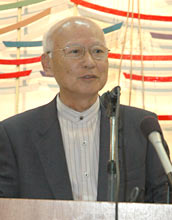
December 5, 2012 Ryukyu Shimpo
On December 5, a seminar entitled “The Senkaku Islands dispute and Okinawa” was held by the Okinawa Human Rights Association in the Yashio-So in Naha. Yotake Kedashiro, chair of the Senkaku Islands Missing-War-Bereaved Association, and Kenichi Uezato, emeritus professor of the University of the Ryukyus and chief of the Okinawa branch of the Japan-China Friendship Association, gave talks and led discussion on ways to ameliorate the confrontation between Japan and China.
Kedashiro talked about the deployment of the Patriot Advanced Capability missile system (PAC 3) on Ishigaki Island by the Japan Self-Defense Force in response to notification from North Korea that a missile would be launched. He is concerned that this may lead to the militarization of the Sakishima Islands. At the same time, Kedashiro called for the Okinawa Prefectural Government to serve as an intermediary between the United States and China.
He said that the memorial service held at sea near the Senkaku Islands by several Diet members was a “political show,” and also said, “I believe that resolving the territorial dispute will make people rethink the so-called threat from China and that the scaling down of U.S. military bases and revision of the Japan-U.S. Status-of-Forces Agreement will then be possible. Those issues can be resolved if Okinawa takes the lead to become a bridge between the United States and China.”
He mentioned that when the PAC 3 was deployed to Ishigaki in April, representatives of the Japan Self-Defense Forces were stationed within the Ishigaki Municipal Office and said, “The relationship between Ishigaki and Japan’s Self-Defense Forces will be strong.” He is concerned that this may become a threat to the peaceful administration of these affairs.
Kenichi Uezato said, “Japan should cancel the nationalization of the Senkaku Islands and devolve custodial rights to Okinawa. This should lead us in the direction of negotiations with the Chinese government. We should recognize that a territorial dispute exists, and Okinawa should offer the Japanese and Chinese governments possible solutions. A problem related to the Senkaku Islands is also Okinawa’s problem.” He said that Okinawa should be leading the way, and speaking up to resolve the issue.”
(English translation by T&CT, Hitomi Shinzato and Mark Ealey)
Go to Japanese
December 8, 2012 Ryukyu Shimpo
Civilians and bereaved families who were victims in the Battle of Okinawa have sued the government, seeking an apology and damages of 11 million yen per person. This group lawsuit is referred to as the Nuchi-do-Takara court-case, which in the Okinawan dialect means, “life is a treasure.” On December 7, 16 plaintiffs in this second lawsuit lodged an appeal to the Naha District Court. They are seeking to force the government to pay damages of 176 million yen. In conjunction with the first lawsuit, the plaintiffs total 56 people.
The age of the plaintiffs in the second lawsuit ranges from 69 to 85 years old, with the average being 76 years old. They include the victims who were wounded during the war, were involved in incidents of mass suicide or were war orphans from the Battle of Okinawa.
(English translation by T&CT, Mark Ealey)
Go to Japanese
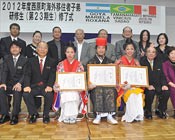
December 7, 2012 Ryukyu Shimpo
On December 4, the graduation ceremony of the 2012 Training Program for students who are children of people who emigrated from Nishihara was held at the Nishihara Chamber of Commerce. This program aims to promote international cultural exchange by accepting the children of people who emigrated. Goya Mariela Roxana from Argentina, Tamanaha Vinicius Sadao from Brazil and Sato Miyahira Jocelyn Ritsuko from Peru received their certificates from Tsunenori Namihira, the superintendent of education.
The students gave a sanshin performance that they had learned during their stay. The approximately 100 people who attended at the ceremony enthusiastically applauded the performance.
Nishihara Mayor Akira Uema praised the students, saying, “You have studied very hard in just a short period of time.”
Goya said in her speech, “I am proud that I have roots in Okinawa.” Tamanaha said, “My dream to visit Okinawa has come true. From today I want to start my journey toward a new dream.” Miyahira said, “Also after returning to Peru, I want to continue to enjoy the sanshin and ryubu (Ryukyu dance).”
(English translation by T&CT, Mark Ealey)
Go to Japanese

December 7 2012 Ryukyu Shimpo
According to the Okinawa Internet White Paper 2012-2013 published by web-design company Lideli Co., Ltd., at the end of October 2012 the number of people using Facebook in Okinawa accounted for 10.3 percent of its online population.
This is second in Japan following Tokyo. It appears that the number increased around the period when the 5th Worldwide Uchinanchu Festival was held last October. The paper suggests that more people started using the Internet in order to communicate with relatives who returned to countries all around the world after the festival.
According to the paper, the online population accounts for 76.8% of Okinawa’s population. This ratio ranks 17th in Japan. The number of active users of Facebook in Okinawa in proportion to its online population is second behind Tokyo, where the ratio is 92.9%.
According to an investigative report that acquired 700 responses from Naha and Chatan, number of people using smartphones in 2012 increased about four times over the previous year. The report suggests that this contributed to the increase in number of people using Facebook and Twitter. Lideli conducted the research by interviewing respondents for about a month from June 2.
The paper reported on Internet use by students from elementary school to high school in Okinawa, and surveyed about 200 Okinawan companies about how they utilize the Internet.
On December 6, at the Okinawa Prefectural Office, Shinya Fukui, the managing director of the company held a press conference regarding the release of the paper. He said, “We definitely want people outside the information technology industry to read the paper.” Lideli will sell the paper at bookstores and convenience stores in Okinawa for 735 yen including tax.
(English translation by T&CT, Mark Ealey)
Go to Japanese
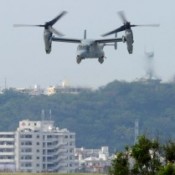
December 8, 2012 Ryukyu Shimpo
In the morning of December 7, three of the 12 Osprey aircraft deployed to U.S. Marine Corps Air Station Futenma in Ginowan flew to Guam for training, arriving there that afternoon. This is the first time that the Osprey aircraft have participated in training conducted outside of Japan. The U.S. military has reported that it started full-scale operation of the Osprey aircraft in Okinawa from December 1 and participation in training conducted in Guam appears to be part of this.
The Osprey crews are scheduled to complete their training on December 18, before returning to Futenma Air Station between December 19 and 21. In response to a question from the Ryukyu Shimpo, a spokesperson of the U.S. Forces Japan Public Affairs Office stated that while they could not release the specific details, the Osprey aircraft were to participate in training in Guam that was beyond the capability of CH-46 helicopters. The spokesperson went on to say that the participation in the training in Guam would decrease the number of flights in Okinawa. At 9:56am on December 7, three Osprey aircraft glided in transition from helicopter to airplane mode, and then took off toward the northeast. A spokesperson of the Okinawa Defense Bureau said that as soon as they receive the relevant information they will inform the related municipalities of the period of the Osprey training to be conducted on the main islands of Japan.
(English translation by T&CT, Mark Ealey)
Go to Japanese
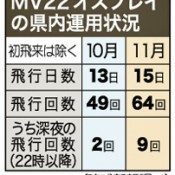
December 1, 2012 Ryukyu Shimpo
On December 1, two months passed since the MV-22 Osprey vertical take-off and landing transport aircraft were deployed to Okinawa. According to investigations carried out by the Ryukyu Shimpo, the number of flights by the aircraft from Futenma Air Station in November (except the first flight) totaled 64 times on 15 separate days. This figure is at least about 1.3 times the number of flights in October, which was 49 times on 13 days.
With regard to Osprey flight training after 10:00pm, which is limited by the noise abatement agreement between the governments of Japan and the United States, the Marine Corps carried out such night flights on nine occasions in November, more than the two flights in October. Sixty percent of reports of sightings provided by residents to the Okinawa Prefectural Government (OPG) stated that the Osprey were flying over urban areas. It is clear that Osprey flight training has intensified. In addition to training carried out in the U.S. military facilities in the northern part of the main island since November, Osprey aircraft flying at low altitude have frequently been seen by residents of Naha and Urasoe. According to the OPG, as of November 29 they had received a total of 465 Osprey sighting reports. Of these, 60 percent, or 280 cases were that the aircraft were flying over the city.
In their agreement, the governments of Japan and the United States confirmed that the Osprey would try to avoid flying over residential districts to the maximum extent possible, the sighting reports indicate that because the bases are concentrated in the small island the Osprey will not be able to fly avoiding above populated areas.
According to noise surveys carried out by the OPG and the Ginowan Municipal Office, 101.3 db was recorded on the November 26 at the Ojana Community Center in Ginowan, and 100.6 db was recorded (initial reports) on November 19 at the same place. On November 26, 74.5 db was confirmed when a CH-46 medium-sized helicopter flew past. According to the survey carried out by Takeshi Tokashiki, associate professor of the University of the Ryukyus, low-frequency sound, which shakes furniture and causes a feeling of pressure, has been confirmed in Ginowan and Nago when the Osprey flies. It was also recorded in Kin Town in addition to these areas. Tokashiki is concerned about the physical and psychological effects this may be causing since the Osprey deployment.
(English translation by T&CT, Mark Ealey)
Go to Japanese
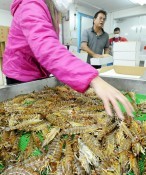
December 2 2012 Ryukyu Shimpo
Into December, all over Okinawa shipment of Japanese tiger prawns, a popular gift during the o-seibo or gift-giving season in early winter, has started in full swing. On November 30, workers at the Japanese tiger prawn farm in Ginoza were busy sorting prawns caught from the sea in the early morning, and packing them into boxes full of sawdust.
The farm ships around 45 tons of prawns per year during the period from October to June. It is reported that the amount shipped in December alone amounts to about eight tons because many people in other prefectures order prawns for the o-seibo season. The busy period peaks in the days to come.
The farm cultivates the prawns in brackish water containing fresh water and salt water rich in plankton. Godzilla, a prawn about 20 centimeters long, is one of the drawing cards at the farm. Itaru Kawasaki, the head of the farm, said, “We have been able to overcome typhoons, and this year have again managed to cultivate prawns that are firm and healthy.”
(English translation by T&CT, Mark Ealey)
Go to Japanese

Go To Video
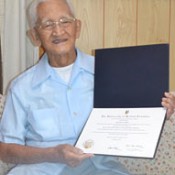
November 27, 2012, Masaaki Umeda of Ryukyu Shimpo
Before World War II, Roy Oshiro enrolled at the University of British Columbia in Canada hoping to become a teacher after graduation. However, the war broke out and he was expelled from the university, discriminated against because he was the son of people of Japanese descent. Now, 70 years later, the university has finally admitted that it was wrong and has decided to bestow degrees to Oshiro and 76 other people of Japanese descent who were also forced to leave the university. Oshiro commented, “These sort of things only happen in once in a 1000 years.”
“I was forced to quit my studies at the university despite not having done anything wrong,” said Oshiro, who was born in Canada as a second generation Japanese, the son of Okinawan parents from Gushikawa Village (now known as Uruma City). Wanting to become a teacher, he enrolled at the University of British Colombia in Vancouver in October in 1941, but just two months later Japanese forces attacked Pearl Harbor and WWII broke out. In March 1942, the Canadian government forcibly relocated 21000 people of Japanese descent living in the coastal province of British Colombia. Oshiro was forced to leave the university, and the government seized all of his assets.
He and his family moved to the province of Alberta in the middle of Canada, and worked on a sugar beet farm for bare minimum wages. After that, he went to a teacher-training school in Calgary, the largest city in Alberta, where he obtained a teaching certificate. The war ended as he was working as a teacher.
In order to become more involved in Christian missionary work he went to seminary school in the 1950s and was ordained. In 1955, he arrived in Okinawa and served as a missionary in his parents’ hometown of Uruma until 2006.
The efforts of the Japanese Canadian Citizens Association in Vancouver led to the awarding of these degrees. Several American universities paid tribute to and bestowed honorary degrees upon people of Japanese descent who had been forced to suspend their studies because of the war. Inspired by this example, from 2008, the Association started to approach the University of British Colombia, and their wish came true on May 30 this year when the special graduation ceremony took place.
Among the 76 people who were expelled from the University of British Colombia, including Oshiro, only 11 could attend the ceremony. After receiving the award, Oshiro said, “Although we were in democratic country, we were treated as if we were slaves and we were frustrated to the point of tears. This should not be repeated.”
When Oshiro was still living in Canada people of Okinawan descent were also discriminated against by other Japanese immigrants. Oshiro said, “I did not like it, but it was a life-learning experience.” While he was pleased to receive the award, with tears in his eyes Oshiro said, “These things only happen in once in a 1000 years.”
(English translation by T&CT, Kyoko Tadaoka and Mark Ealey)
Go to Japanese

November 27, 2012 Takahiro Miyagi of the Ryukyu Shimpo
On November 14, the rock band Shores released its first album called Beginning | End through BORNtoLOVE Records. Produced by MEG from 2side1BRAIN and SHUNTAROCK, the album sells for 1575 yen, and contains eight songs with constructive messages with lyrical melodies and distinctive vocals. The band was originally formed back in 2010 by one American and four Japanese-Americans aged between 18 and 25 years old.
Their early performances were in Chatan and Okinawa City, but in 2011 the band stopped playing after the murder of guitarist Eddie. One of them commented, “Then we lost our way.”
However, fans and members of other bands in Japan sent them messages of encouragement, and these messages pushed them to start recording in earnest. As a result, this year they completed the album.
In the song Westward March on the album, they sing that, “We should be able to break down the wall in front of us.”
The band members say that they hope to develop their uniqueness and become the only band of our kind in Japan. Their fans are not only rock-kids, but also young Japanese-Americans caught up in language and cultural differences. They said that they want to be people who can give hope to such young Japanese-Americans. They understand the feelings of the people living inside and outside the U.S. military bases, and feel sad every time base-related accidents and incidents occur.
Bass guitarist Sean, said, “It is really unfortunate that someone’s bad behavior makes everyone look bad. We should view others as human beings and not as Japanese or Americans.” Vocalist Thomas said, “Mutual respect is important. Music is a universal language that allows us to share time together without actually talking.”
(English translation by T&CT, Hitomi Shinzato and Mark Ealey)
Go to Japanese
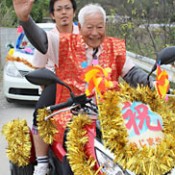
November 29, 2012 Ryukyu Shimpo
On November 24, a celebration known locally as kajimaya was held for 96 year-old Shinfuku Tamaki at his home in Takazato, Ogimi. He obtained his driving license before Okinawa’s return to Japanese sovereignty, and has been riding a motorcycle for more than 50 years. During the celebration, he paraded around on a motor trike with his grandson Yujin on the back. Tamaki smiled at people who came to celebrate his longevity.
At Tamaki’s home, his relatives celebrating with him wore polo shirts with their house’s name, Mijigwa, printed on them. Tamaki enjoys playing with his grandchildren and said, “I’m very happy that everyone wishes me well like this.”
Tamaki, who was born in Takazato, Ogimi, was drafted during WWII and spent seven years in China and the Solomon Islands. After he returned to Ogimi via Kumamoto, he married Fumi. Now he works at an orange grove and has five children, eight grandchildren and six great-grandchildren.
Tamaki has ridden a motorcycle since getting his driving license. It is well known among locals that he goes out to the orange grove on his beloved motorcycle Kabu-go every day, and people say that seeing this keeps them cheerful.
It is the first time in 25 years that a kajimaya celebration has been held in Takazato. Tamaki said the key to good health is “not trying too hard.” He suffered from vascular disease in his 70s but is in perfect health these days. He said that in a recent check-up, the doctor told him that his body is the same as that of a 70 year-old and he is capable of living over 100 years old. Tamaki smiled as he said, “I’m going to live a long life.”
(English translation by T&CT, Lima Tokumori and Mark Ealey)
Go to Japanese

November 18, 2012 Yukito Kinjo of the Ryukyu Shimpo
The Fisheries Cooperative Association of Ie has created Iejima Mozuku Jelly containing fucoidan essence. On October 31, in order to promote the product, Ryuichi Hachimae, the president of the Association, visited Mayor Katsumasa Oshiro at the Ie Municipal Office.
The Fisheries Cooperative Association has been working since last year to develop a health-promoting jelly as a product that can help sustain the demand for mozuku harvested in the village. This March, they offered samples at three local schools and received positive feedback from the students.
Hachimae said, “By a process of trial and error, we have developed an easy-to-eat food product containing fucoidan and fiber.” After tasting a sample, Mayor Oshiro said, “It has a pineapple flavor and is just the right size. It is made to be enjoyed by all ages from kids to older people.” Samples were offered to students at three schools on November 1.
A bag of ten cups of Mozuku Jelly sells for 360 yen. Part of the revenue will be donated to the Village Youth Educational Activity Fund and used to support art activities.
The Association and the Ie-jima Products Center in Ie Port have marketed and sold the jelly from November 1. On November 10, it was available at the Village Industry Festival and Remote Islands Fair.
(English translation by T&CT, Megumi Chibana and Mark Ealey)
Go to Japanese











 Webcam(Kokusai Street)
Webcam(Kokusai Street)


